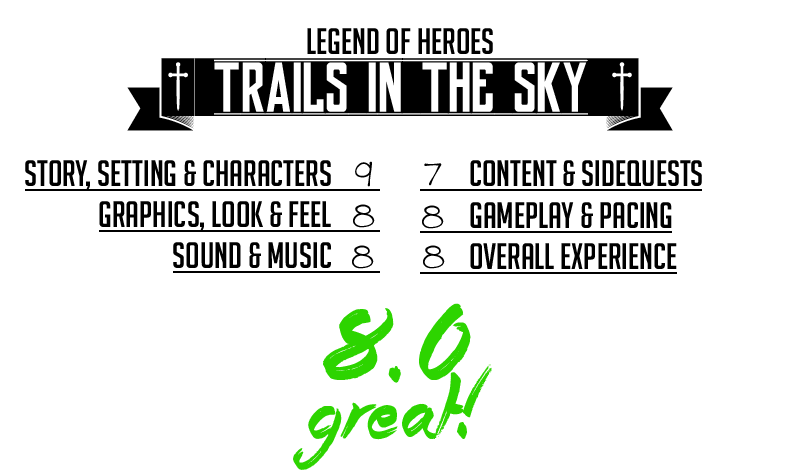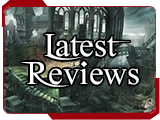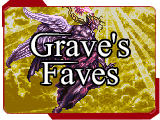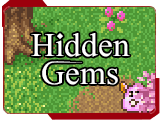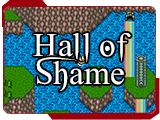
Available On: RPG Maker (PC) (2015)
RPG Maker Version: RPG Maker VX Ace
Game Length: ~1 hour
Story, Setting & Characters — 6/10
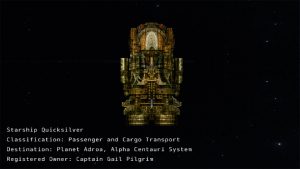 The opening episode of Space Pilgrim starts off fairly simply — you play the part of Gail Pilgrim, the captain of the small transport starship Quicksilver. Initially being tasked to locate your passengers, things quickly and inevitably go very wrong. While there are a few unexpected twists here and there, the story is largely quite simple — albeit entertaining enough — and covers about an hour’s worth of gameplay.
The opening episode of Space Pilgrim starts off fairly simply — you play the part of Gail Pilgrim, the captain of the small transport starship Quicksilver. Initially being tasked to locate your passengers, things quickly and inevitably go very wrong. While there are a few unexpected twists here and there, the story is largely quite simple — albeit entertaining enough — and covers about an hour’s worth of gameplay.
Aside from your passengers — and the ornery ship’s cat — there are a few other characters you’ll encounter on this short adventure. While the writing is mildly humorous, the characters are fairly basic archetypes with little surprise or variation, and the setting — at least, what can be seen in the small amount of story offered in this first episode — seems to be entirely generic and fairly bland space sci-fi.
It’s an entertaining little romp, but don’t expect anything that’ll blow you out of the water.
Graphics, Look & Feel — 7/10
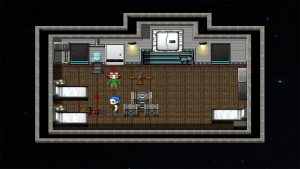 For an RPG Maker game, Space Pilgrim Episode I looks pretty fantastic — but given the engine’s significant limitations, that’s not really saying much when comparing it to other RPGs as a whole. I didn’t spot any RTP assets used at all here, the high-tech graphics are all pretty excellent and the game world is well-designed in general, albeit consisting of a number of very small, fairly dense rooms.
For an RPG Maker game, Space Pilgrim Episode I looks pretty fantastic — but given the engine’s significant limitations, that’s not really saying much when comparing it to other RPGs as a whole. I didn’t spot any RTP assets used at all here, the high-tech graphics are all pretty excellent and the game world is well-designed in general, albeit consisting of a number of very small, fairly dense rooms.
The user interface consists largely of an inventory (which allows for both using and combining items), a functional yet largely unnecessary journal and quest tracking system, and dialogue boxes when interacting with people and objects in the game world. The attention to detail is nice and the overall visual experience is a cut above many other RPG Maker games, yet still distinctly average when compared to the RPG genre as a whole.
Sound & Music — 6/10
There’s honestly very little to say in this category — the sound effects are competent and the music is entirely forgettable.
Content & Sidequests — 5/10
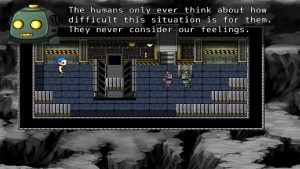 This is, unfortunately, one of the weakest points of the game — with no combat system, the game plays more like a point-and-click adventure than anything. The story and gameplay is extremely linear, with puzzles only having a single solution which must be solved in a specific order, and aside from examining random objects and chatting to NPCs, there’s nothing to actually do outside of following the short, linear story.
This is, unfortunately, one of the weakest points of the game — with no combat system, the game plays more like a point-and-click adventure than anything. The story and gameplay is extremely linear, with puzzles only having a single solution which must be solved in a specific order, and aside from examining random objects and chatting to NPCs, there’s nothing to actually do outside of following the short, linear story.
Fortunately, there’s enough of a sense of urgency to keep the story rolling and to keep the player motivated, though it’s easy to finish the entire game in an hour or less, so there isn’t a great deal of content in general to speak of. What little exists is entertaining and amusing enough, but I feel like slapping “Episode I” onto the name isn’t quite enough to justify such a short game experience.
Gameplay & Pacing — 7/10
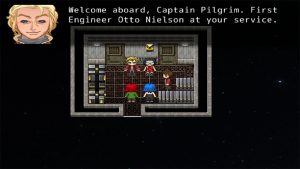 The actual gameplay is fairly solid, albeit rather simple and completely linear, which almost makes this game more of a visual novel than an RPG. You are free to explore a number of (fairly small) areas, solving puzzles in order to achieve various goals and progress the story. This is generally done by either interacting with NPCs or computers, or by collecting, combining and using various items in a point-and-click-adventure style manner.
The actual gameplay is fairly solid, albeit rather simple and completely linear, which almost makes this game more of a visual novel than an RPG. You are free to explore a number of (fairly small) areas, solving puzzles in order to achieve various goals and progress the story. This is generally done by either interacting with NPCs or computers, or by collecting, combining and using various items in a point-and-click-adventure style manner.
The (short) story is decently-told and there isn’t any unnecessary padding here — each objective is always fairly clear and reasonably within reach, with small portions of story exposition between some of the goals. The puzzles tend to be extremely easy and take very little effort to solve, however, especially as every item in the game tends to have one single purpose.
Overall Experience — 7/10
 Space Pilgrim Episode I shows some promise and is an amusing little adventure to while away an hour, though its lack of length, depth, and complexity certainly mars the potential it could have had to be a much better game. The low price point is extremely reasonable (£0.99 on Steam) and it’s worth trying if you want something lightweight and fun to fill a little space in your day, but don’t expect anything too deep or original.
Space Pilgrim Episode I shows some promise and is an amusing little adventure to while away an hour, though its lack of length, depth, and complexity certainly mars the potential it could have had to be a much better game. The low price point is extremely reasonable (£0.99 on Steam) and it’s worth trying if you want something lightweight and fun to fill a little space in your day, but don’t expect anything too deep or original.
My biggest complaint is that, unlike other puzzle-adventure games, there’s never a situation where there are multiple puzzles which can be solved in any order. At any given time, there’s one single objective or puzzle to be solved, then once that’s done, it’s on to the next. This, combined with each item only having a single use, makes for a fairly bland experience.
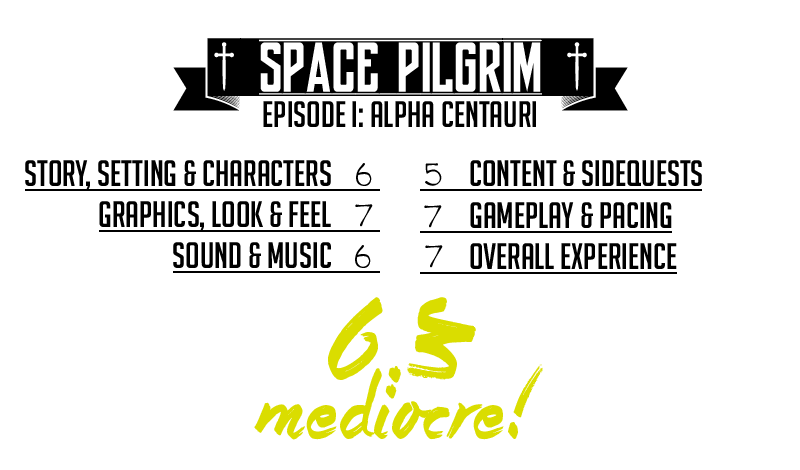
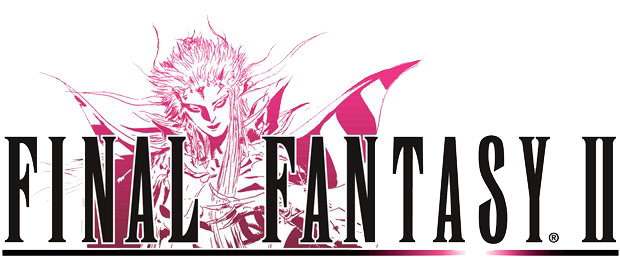
This Review: PlayStation Portable (2007)
Game Length: 25-30 hours
Critic Rating: 63% aggregateThe aggregate critic rating is based on independent review scores from several other websites.
Story, Setting & Characters — 6/10
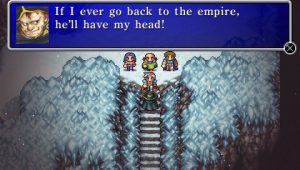 The story in Final Fantasy II is leaps and bounds ahead of the fairly simplistic narrative of the first game, and while fairly thin by today’s standards, it’s still moderately salvageable. The game begins with four youths — Firion, Maria, Guy and Leon — fleeing from their home city of Fynn, which is under siege from the forces of the evil Palamecian Empire. Left for dead after an ambush, three of the survivors are rescued by rebel forces and brought back from the brink of death, while Leon is nowhere to be found.
The story in Final Fantasy II is leaps and bounds ahead of the fairly simplistic narrative of the first game, and while fairly thin by today’s standards, it’s still moderately salvageable. The game begins with four youths — Firion, Maria, Guy and Leon — fleeing from their home city of Fynn, which is under siege from the forces of the evil Palamecian Empire. Left for dead after an ambush, three of the survivors are rescued by rebel forces and brought back from the brink of death, while Leon is nowhere to be found.
The trio joins forces with the rebel army and begins a quest across the world to acquire magical artifacts and equipment to battle the Emperor’s forces and restore peace to the war-ravaged world. It’s pretty standard magical-fantasy RPG faire, though was a great deal more original when the NES original of the game was released, compared to today with a similar plot being re-used ad nauseum by less inspired games.
The world’s setting is fairly generic high-fantasy with the unsurprising twist of the Empire being more technologically advanced than the rest of the kingdoms. While fairly varied, the game world is really nothing to write home about, nor are the characters who tend to be little more than set-pieces who barely (if at all) change throughout the course of the game.
Graphics, Look & Feel — 7/10
 One of the stronger points of the game are the graphics — the PSP version of the game looks fantastic, with well-detailed and colourful characters, varied and attractive locations, and overall a top-notch job on updating the look and feel of the original to something more modern and palatable. The enemy sprites in battles are similarly excellent; large, colourful and well-made art that really brings the game world to life.
One of the stronger points of the game are the graphics — the PSP version of the game looks fantastic, with well-detailed and colourful characters, varied and attractive locations, and overall a top-notch job on updating the look and feel of the original to something more modern and palatable. The enemy sprites in battles are similarly excellent; large, colourful and well-made art that really brings the game world to life.
Unfortunately, while the art assets themselves are stellar, there are a few points which bring this score down significantly. First and foremost, the overworld map looks terrible. While the graphics may be solid, the world is simply far larger than it reasonably needs to be, consisting almost entirely of pointlessly empty wilderness with few variations. Similarly, dungeon layouts are uninspired and often fairly predictable in their design, and you’ll be facing recolours of the same enemy sprites over and over again — this can be forgiven to an extent, given that it’s a remake of a NES game, but that doesn’t excuse the poor use of such fantastic art.
The major exceptions to this rule are two of the last areas in the game — the Jade Passage and Pandemoneum, the latter of which especially is a visual treat and a stunningly bizarre experience.
Sound & Music — 8/10
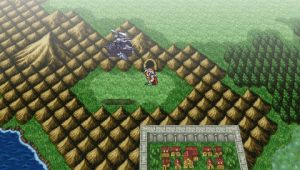 While somewhat of a mixed bag, the musical score of Final Fantasy II is largely pretty solid, as one would expect from a Final Fantasy title. Some of the tracks from the small soundtrack are fairly mediocre and forgettable, while others — such as Castle Pandemoneum — are every bit as epic and inspired as one could hope for. For the most part, though, it’s about on par with what anyone would expect from an early Final Fantasy — above-average, but not quite up to the sheer epic levels that later games in the series achieved.
While somewhat of a mixed bag, the musical score of Final Fantasy II is largely pretty solid, as one would expect from a Final Fantasy title. Some of the tracks from the small soundtrack are fairly mediocre and forgettable, while others — such as Castle Pandemoneum — are every bit as epic and inspired as one could hope for. For the most part, though, it’s about on par with what anyone would expect from an early Final Fantasy — above-average, but not quite up to the sheer epic levels that later games in the series achieved.
The sound effects in the game are purely adequate and, honestly, entirely forgettable in their adequacy. They do the job well enough and there’s no real complaints to be had, but it’s hard to think of any particular praise to offer.
Content & Sidequests — 5/10
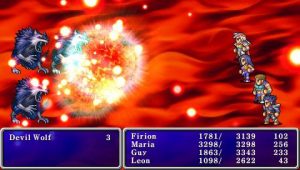 I’m sorry to say, but disappointment is the name of the game when it comes to the actual content of Final Fantasy II. The huge game world is largely barren and populated only by a handful of towns, castles and caves, and the gameplay consists almost entirely of visiting a town, talking to some people, then delving into a nearby dungeon to collect an item. Rinse, lather, repeat — it’s the very core of JRPG gameplay with none of the extra fluff that makes the experience worthwhile, and after exploring yet another maze-like dungeon filled with the exact same kind of dead-ends and trap-rooms, it all starts to blur together into a tedious mess.
I’m sorry to say, but disappointment is the name of the game when it comes to the actual content of Final Fantasy II. The huge game world is largely barren and populated only by a handful of towns, castles and caves, and the gameplay consists almost entirely of visiting a town, talking to some people, then delving into a nearby dungeon to collect an item. Rinse, lather, repeat — it’s the very core of JRPG gameplay with none of the extra fluff that makes the experience worthwhile, and after exploring yet another maze-like dungeon filled with the exact same kind of dead-ends and trap-rooms, it all starts to blur together into a tedious mess.
Side-quest content does exist for the PSP version, though it’s barely worth the effort — a few optional dungeons and the like, which offer exactly nothing special compared to the already boring experience of the existing storyline dungeons.
I hope you enjoy dungeons, because that’s pretty much all this game is about.
Gameplay & Pacing — 7/10
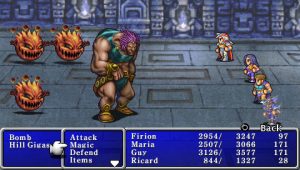 A thoroughly mediocre score for a thoroughly unremarkable experience — the gameplay of Final Fantasy II is competent enough, though largely lacking in depth and variety. It’s a fairly standard side-view, party-based battle system that any RPG aficionado will have seen a hundred times before. Your heroes can equip a variety of armour and weapons — some of which offers some tangible benefit beyond its stats, but for the most part, there’s little of interest beyond Generic Sword A being slightly stronger than Generic Axe B.
A thoroughly mediocre score for a thoroughly unremarkable experience — the gameplay of Final Fantasy II is competent enough, though largely lacking in depth and variety. It’s a fairly standard side-view, party-based battle system that any RPG aficionado will have seen a hundred times before. Your heroes can equip a variety of armour and weapons — some of which offers some tangible benefit beyond its stats, but for the most part, there’s little of interest beyond Generic Sword A being slightly stronger than Generic Axe B.
One curiosity about the game is the fact that there are no levels. Instead, characters improve their stats by doing — casting spells will increase a character’s intellect and mana pool, fighting in melee combat will increase strength, being hit by enemies will boost agility and hit points, and so on. It’s a much-maligned system that many find annoying and unwanted, but I found it to be quite flexible and easy to use, albeit uninteresting. Despite their initial allocation of stats, any of your heroes can be trained to perform just about any role, but this results in a muddy mess of homogeneity.
Moreover, the lack of predefined classes means that nobody has any interesting special abilities — anyone can cast a spell if they want, but there’s no Steal, there’s no Jump, nor any other special ability you may come to expect from a Final Fantasy title.
Overall Experience — 6/10
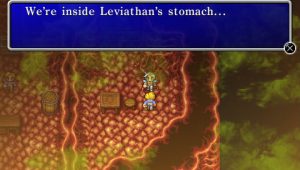 The best way to describe Final Fantasy II would be like a Fabergé egg; it’s pretty enough on the outside, but there’s no real substance or depth to it. While it’s interesting from a purely historical perspective, and entirely playable for those of us crazy enough to want to complete all of the main-series Final Fantasy games, there’s just really nothing here that I’d actually recommend to anyone.
The best way to describe Final Fantasy II would be like a Fabergé egg; it’s pretty enough on the outside, but there’s no real substance or depth to it. While it’s interesting from a purely historical perspective, and entirely playable for those of us crazy enough to want to complete all of the main-series Final Fantasy games, there’s just really nothing here that I’d actually recommend to anyone.
The story is thin and largely uncompelling, the characters are set pieces at best (convenient tools at worst), the gameplay is thoroughly stale and medicocre, the gameplay mechanics are easily broken and abused (not to mention atrociously poorly-balanced), and I think I’ve laid into this game quite enough already and it’s time to stop beating the dead horse and agree with what most other people on the internet tend to say — that Final Fantasy II is one of the worst, if not the weakest entry in the series, and of interest only to die-hard fans and completionists.
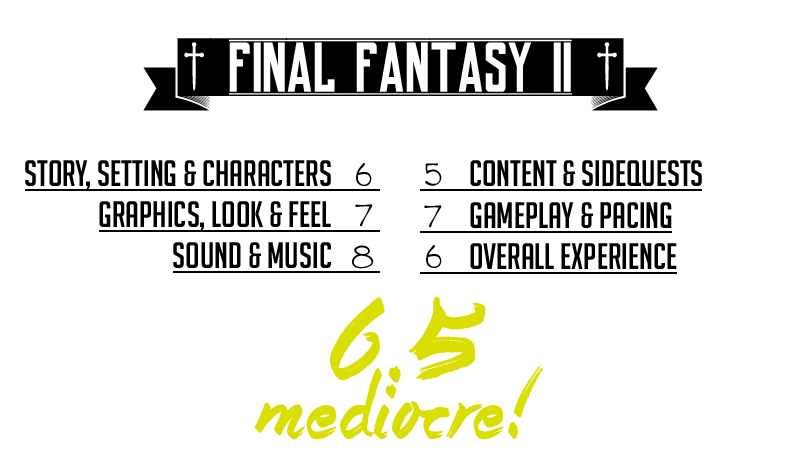
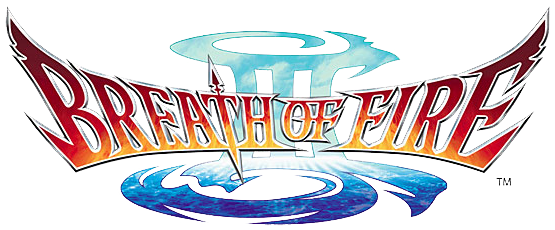
This Review: PlayStation Portable (2006)
Near-Identical Versions: Sony PlayStation (1998)
Game Length: 40-48 hours
Critic Rating: 67% aggregateThe aggregate critic rating is based on independent review scores from several other websites.
Story, Setting & Characters — 7/10
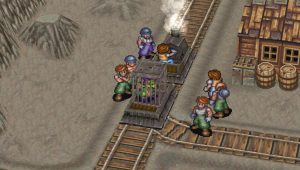 Breath of Fire III starts in a rather unconventional manner — you play the part of Ryu, an infant dragon (yes, an actual dragon) who has been freed from a fossilized egg by a hapless mining crew. After running rampant for a few brief, glorious moments, Ryu is captured and caged, before managing to escape again where — now taking the form of a human child — he is found lost and afraid in the woods by a kind-hearted rogue and his young accomplice.
Breath of Fire III starts in a rather unconventional manner — you play the part of Ryu, an infant dragon (yes, an actual dragon) who has been freed from a fossilized egg by a hapless mining crew. After running rampant for a few brief, glorious moments, Ryu is captured and caged, before managing to escape again where — now taking the form of a human child — he is found lost and afraid in the woods by a kind-hearted rogue and his young accomplice.
Thus begins the first half of the game, an absolutely charming experience following the exploits of the young troublemakers as they steal food, challenge monsters, and cause all manner of headaches for the townspeople and the local corrupt lord. We see the vibrant, colourful fantasy world through a child’s eyes, and this veil of optimism helps to shroud the darker nature of the game’s events.
Needless to say, it’s not all fun and games, and things inevitably go horribly wrong — Ryu has to set off on a journey across the land, meeting new friends and facing dangerous foes, many of whom wish to slay or enslave the dragon-child. While the world leans heavily towards a rather generic medieval/magical fantasy style, there are some elements of technology seen here and there, albeit mostly in the form of relics unearthed from a lost age.
The biggest paradigm shift takes place about half-way through the game, where the plot jumps forward several years and we play as an adult Ryu. With the childlike innocence gone, the plot becomes much more sombre and — in my opinion — far less interesting and far too stretched-out, with a shift towards a more post-apocalyptic world setting which fits poorly with the game’s aesthetic and feels clumsily forced into the story.
For the most part, the setting is fairly generic, the story starts off on a strong point then starts to peter out, but the characters are strong enough in themselves — each having a very distinct and unique personality — to warrant a reasonable score in this category.
Graphics, Look & Feel — 8/10
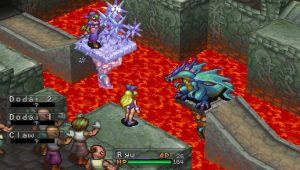 The graphical style of the game is definitely one of its stronger points — with a largely-fixed (allowing for some small amount of rotation) isometric camera angle, the bulk of the game world is built up from 3D polygons with decent texturing hampered only by the hardware’s limitations, while all the characters, NPCs, enemies and such in the game are rendered as 2D sprites from an isometric perspective. This allows for much more detail and customization to the sprites than would be possible if they were 3D models, and for the most part, the art style is absolutely charming and a pleasure to behold.
The graphical style of the game is definitely one of its stronger points — with a largely-fixed (allowing for some small amount of rotation) isometric camera angle, the bulk of the game world is built up from 3D polygons with decent texturing hampered only by the hardware’s limitations, while all the characters, NPCs, enemies and such in the game are rendered as 2D sprites from an isometric perspective. This allows for much more detail and customization to the sprites than would be possible if they were 3D models, and for the most part, the art style is absolutely charming and a pleasure to behold.
The world is — again, for the most part — colourful and vibrant, varied and well-detailed. While the more cartoonish approach to the visuals may not appeal to everyone, I think it fits the mood of the game excellently. The user interface is easy-to-use and similarly well-designed, with a charming simplicity that belies the more complex gameplay beneath.
Sound & Music — 8/10
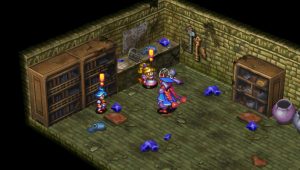 The soundtrack to the game is excellent — not as ground-breakingly epic as something from a Final Fantasy game might be, but compared to the majority of other RPGs, it stands strong and is a worth addition to the game. Much like the rest of the setting, the soundtrack feels upbeat and charmingly innocent, fitting perfectly with the visuals, evoking a sense of wonder and adventure.
The soundtrack to the game is excellent — not as ground-breakingly epic as something from a Final Fantasy game might be, but compared to the majority of other RPGs, it stands strong and is a worth addition to the game. Much like the rest of the setting, the soundtrack feels upbeat and charmingly innocent, fitting perfectly with the visuals, evoking a sense of wonder and adventure.
The sound effects are solid and fit well with the gameplay, with each character having a few voice lines while performing special attacks or casting spells. While this can get a little repetitive — you’ll be hearing Rei’s cry of “Itadaki~!” a great deal in the adventure — it mostly fits well with the rest of the game, adding to the generally charming experience. Attacks and magic sound satisfying and powerful, and one particularly enjoyable part is seeing Ryu’s progression from initially flailing his sword with a frightened cry, into becoming a more confident swordsman.
Content & Sidequests — 7/10
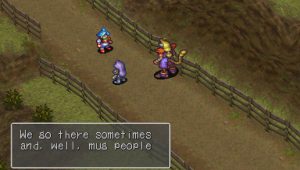 The main game’s story is quite hefty in length — at least 40 hours long, likely more — and progresses through a fairly interesting variation of locations. Early-game — largely during Ryu’s childhood — the game features a variety of events and activities, ranging from raiding a nobleman’s mansion and fighting ghosts, to fighting in a gladiatorial arena. Unfortunately, the latter half of the game descends largely into the less-interesting trope of trudging through fairly large, maze-like dungeons, more for the sake of doing so than for any real story necessity.
The main game’s story is quite hefty in length — at least 40 hours long, likely more — and progresses through a fairly interesting variation of locations. Early-game — largely during Ryu’s childhood — the game features a variety of events and activities, ranging from raiding a nobleman’s mansion and fighting ghosts, to fighting in a gladiatorial arena. Unfortunately, the latter half of the game descends largely into the less-interesting trope of trudging through fairly large, maze-like dungeons, more for the sake of doing so than for any real story necessity.
As far as side activities go, there isn’t a huge amount to speak of here — there’s a fairly enjoyable fishing mini-game which can be skipped entirely but can offer some decent rewards (and is quite fun for its own sake), a rather stilted and poorly-explained village management ‘simulation’ where you must guide a village of faeries towards rebuilding their wrecked settlement (which can result in being given gifts or offered items for sale that are not available elsewhere), and some other minor content such as hunting powerful monsters, or playing hide-and-seek with kids in town.
For the most part, though, the game is largely linear and focuses more on telling a story rather than letting the player off the leash to wander too far. You’ll frequently find yourself constrained to small portions of the game world, and while the fishing and faerie village can be accessed from many locations, side content is definitely treated with low priority.
Gameplay & Pacing — 7/10
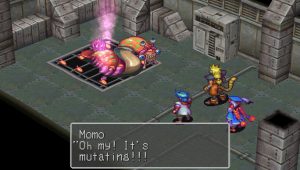 The gameplay in Breath of Fire III is largely average as far as JRPGs go — it’s competent and enjoyable, but doesn’t really stand out in any particular regard. One particularly nice point is the way combat is handled — while wandering around the game world, getting pulled into a random encounter will actually have the battle take place right where you are in the game world, rather than transitioning into a separate ‘battle screen’.
The gameplay in Breath of Fire III is largely average as far as JRPGs go — it’s competent and enjoyable, but doesn’t really stand out in any particular regard. One particularly nice point is the way combat is handled — while wandering around the game world, getting pulled into a random encounter will actually have the battle take place right where you are in the game world, rather than transitioning into a separate ‘battle screen’.
Combat has an intuitive and well-designed, icon-based interface for attacking and using items or special abilities, most characters can learn both spells and also learn certain special moves they observe from enemies, and Ryu in particular has the ability to combine a number of ‘dragon genes’ together to transform into one of several different types of dragons, each with its own unique characteristics and abilities.
The pacing is best described as questionable — as mentioned above, I felt as though the child-Ryu parts of the game were fantastic, but once we get to the adult-Ryu storyline, things feel as though they’re dragging on a little longer than is strictly necessary. It’s a minor complaint and may not bother everyone, but I feel it’s worth another mention.
Overall Experience — 7/10
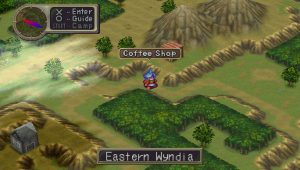 For the most part, Breath of Fire III is a competent and enjoyable JRPG with some interesting and original twists, and an absolutely adorable aesthetic that’s hard not to love. It’s a far cry from perfect and certainly has its fair share of flaws, but as an overall experience it’s something I’d recommend at least trying to see if it appeals to you — after all, there aren’t many games where the main character is a literal dragon.
For the most part, Breath of Fire III is a competent and enjoyable JRPG with some interesting and original twists, and an absolutely adorable aesthetic that’s hard not to love. It’s a far cry from perfect and certainly has its fair share of flaws, but as an overall experience it’s something I’d recommend at least trying to see if it appeals to you — after all, there aren’t many games where the main character is a literal dragon.
If you’re looking for a super serious storyline, full of emotional rollercoasters and jarring surprises, then Breath of Fire III is certainly not the game for you. But if you’d like to experience a more light-hearted, vibrant, colourful and charming world with well-written characters and entertaining dialogue, then you can’t go far wrong by giving this one a fair try.
While the PlayStation Portable version is slightly improved over the PlayStation original — particularly in terms of a slightly improved soundtrack — both versions are solid and competent, and near-identical experiences.
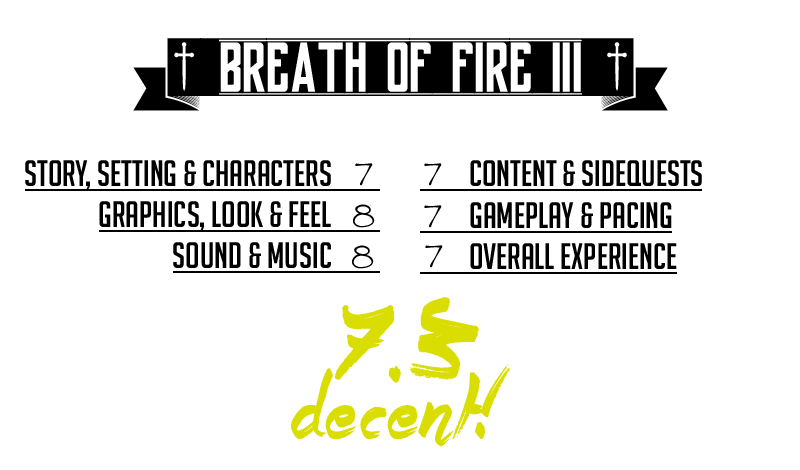
Grave's RPG Reviews
Game Boy Advance · Nintendo 2DS/3DS · PC · PlayStation · PlayStation 3
PlayStation 4 · PlayStation Portable · PlayStation Vita · RPG Maker · SNES · Switch · Wii
WiiU · Xbox 360 · Xbox One
Ghost in a Bottle
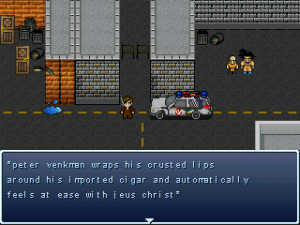 Deciding it was time for another RPG Maker game review, I thought it could be fun to browse the list of games on rpgmaker.net, but set the sorting to random and pick the first item on the list. What could go wrong, I thought. It could be fun, I thought.
Deciding it was time for another RPG Maker game review, I thought it could be fun to browse the list of games on rpgmaker.net, but set the sorting to random and pick the first item on the list. What could go wrong, I thought. It could be fun, I thought.
After all, it couldn’t be much worse than Eternal Destiny, right?
Well, as it turns out…
Essential Information
Available On: RPG Maker (PC) (2009)
Author: TFT
RPG Maker Version: RPG Maker 2000
Game Length: <1 hour
Download Link rpgmaker.net
Grave’s Thoughts
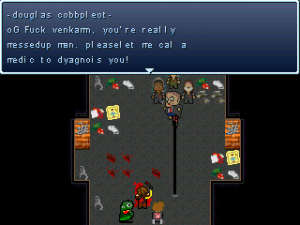 I knew this was going to be terrible from the screenshots alone, but I wasn’t quite prepared for the levels of sheer bizarre awfulness present in this mercifully short game. Perhaps the most disturbing aspect is the amount of effort that seems to have gone into making this strange joke of a game — while the music is blatantly stolen from other games (mostly in the form of bad MIDI files), and I can only assume the art is mostly lifted from other sources (aside from a few exceptions, such as a very poorly-drawn, human-sized penis), some amount of effort seems to have been put into the map construction and ‘cutscenes’.
I knew this was going to be terrible from the screenshots alone, but I wasn’t quite prepared for the levels of sheer bizarre awfulness present in this mercifully short game. Perhaps the most disturbing aspect is the amount of effort that seems to have gone into making this strange joke of a game — while the music is blatantly stolen from other games (mostly in the form of bad MIDI files), and I can only assume the art is mostly lifted from other sources (aside from a few exceptions, such as a very poorly-drawn, human-sized penis), some amount of effort seems to have been put into the map construction and ‘cutscenes’.
Don’t let this fool you into thinking that Ghost in a Bottle is anything beyond an absolute train-wreck, however — the extremely short game (about half of which consists of scripted cutscenes) has a largely-incomprehensible plot, due in no small part to the plethora of what I can only assume are intentional spelling errors strewn across the bizarrely lengthy dialogue. Playing the role of a wheelchair-bound kid and apparent Ghostbuster-wannabe, you are thrust into a 4chan-esque convoluted mess of memes, in-jokes, and what can only be described as the worst Ghostbusters fanfiction ever written.
If this sounds even remotely interesting, like something you might want to download and try for yourself just for a laugh — trust me, it’s not. This hectic conglomeration of meme-like content seems to be trying its absolute best to be both offensive and amusing, and fails spectacularly on both counts. The combat system is random, poorly-cut-out JPEGs set to an awful MIDI mix of Butterfly, the questing is as complicated as talking to a few nonsensical NPCs and pressing a switch, and the whole thing looks like something that a 12-year-old probably thought was the height of hilarity and originality.
But hey, there’s a silver lining, at least: surely the next RPG Maker game I play can’t be any worse than this…
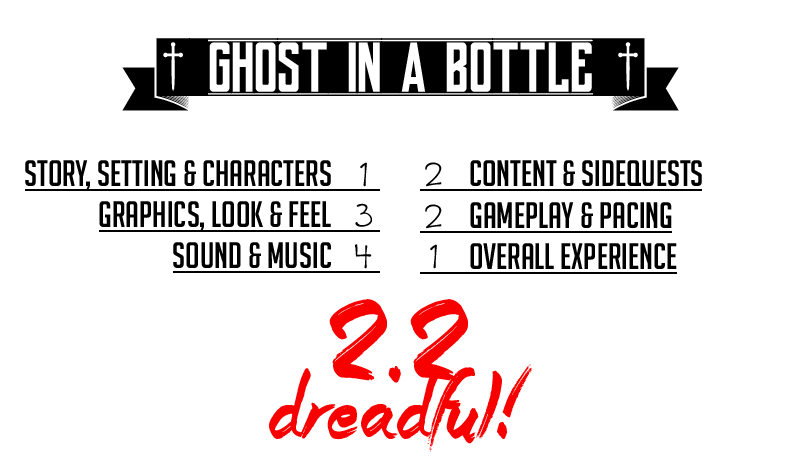
Grave's RPG Reviews
Game Boy Advance · Nintendo 2DS/3DS · PC · PlayStation · PlayStation 3
PlayStation 4 · PlayStation Portable · PlayStation Vita · RPG Maker · SNES · Switch · Wii
WiiU · Xbox 360 · Xbox One
Legend of Heroes: Trails in the Sky
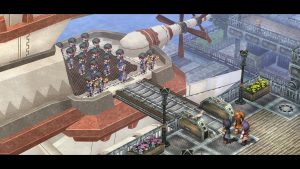 Until a few months ago, I’d actually never heard of the Legend of Heroes series before, let alone any particular LoH game, and yet the internet seems to be all abuzz lately regarding Trails in the Sky: the first part of a trilogy of RPG games by Nihon Falcom, also known for making the Ys series. Originally released in Japan in 2004 (though the Legend of Heroes series as a whole dates back to 1989!), Trails in the Sky was more recently released to Western markets, and seems to have been a pretty big hit.
Until a few months ago, I’d actually never heard of the Legend of Heroes series before, let alone any particular LoH game, and yet the internet seems to be all abuzz lately regarding Trails in the Sky: the first part of a trilogy of RPG games by Nihon Falcom, also known for making the Ys series. Originally released in Japan in 2004 (though the Legend of Heroes series as a whole dates back to 1989!), Trails in the Sky was more recently released to Western markets, and seems to have been a pretty big hit.
It’s now 6am and I’ve been up all night trekking through the last few morsels of the game, exploring dungeons and battling foes, and finding myself rather taken aback by some suddenly unexpected plot twists at the very end of the story. It’s time to see what all the fuss is about.
Essential Information
This Review: PC/Windows (2014)
Near-Identical Versions: PlayStation Portable (2011), PlayStation 3 (2012, Japan-only), PlayStation Vita (2015, Japan only)
Game Length: 42-50 hours
Critic Rating: 85% aggregateThe aggregate critic rating is based on independent review scores from several other websites.
Grave’s Thoughts
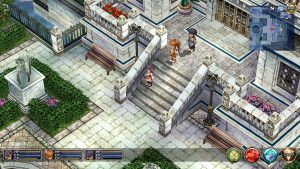 Legend of Heroes: Trails in the Sky — the first part of the Trails in the Sky trilogy — is a charming, colourful, exciting, and only somewhat flawed coming-of-age story. It follows the adventures of Estelle Bright — a spunky tomboyish type always looking for a fight, the daughter of a renowned and well-respected member of the Bracer Guild — and her adopted brother, Joshua, a more serious and thoughtful boy with a mysterious past. The story starts fairly slow and simple, with the brother-sister duo finishing their training and joining as junior Bracers, performing odd jobs around town and helping the citizens with missing pets and lost property. Think of the Bracers as a combination civilian police force and lawful-good mercenaries, and as the most junior members, Estelle and Joshua set off on charming yet low-key adventures as they try to get their bearings.
Legend of Heroes: Trails in the Sky — the first part of the Trails in the Sky trilogy — is a charming, colourful, exciting, and only somewhat flawed coming-of-age story. It follows the adventures of Estelle Bright — a spunky tomboyish type always looking for a fight, the daughter of a renowned and well-respected member of the Bracer Guild — and her adopted brother, Joshua, a more serious and thoughtful boy with a mysterious past. The story starts fairly slow and simple, with the brother-sister duo finishing their training and joining as junior Bracers, performing odd jobs around town and helping the citizens with missing pets and lost property. Think of the Bracers as a combination civilian police force and lawful-good mercenaries, and as the most junior members, Estelle and Joshua set off on charming yet low-key adventures as they try to get their bearings.
Right off the bat, you can tell this game is very strongly anime-inspired, even moreso than your average JRPG. Not that I mean that as a bad thing, mind — the world is absolutely charming and quite attractive to behold, with memorable and likeable characters and sinister villains alike. The game seems to lull early on, with little sense of urgency or depth to the plot as our heroes travel from town to town across the kingdom, but I’d implore anyone willing to try the game to give it a fair try — “play until the play” is a phrase I’ve heard a number of times regarding Trails in the Sky, and it’s an apt suggestion. While the story may seem fairly low-key and simple early on, it unfolds into something more interesting and sinister as time passes, with some truly unexpected twists near the end, leaving the story open for the sequel to pick up where it left off.
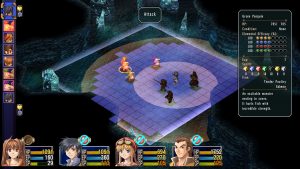 Let’s talk game mechanics: Nihon Falcom are no strangers to experimenting with existing formulas, and the Trails series is no exception. Combat takes place on a two-dimensional grid similar to something one might see in a Final Fantasy Tactics or Fire Emblem game, albeit with a great deal less complexity. Positioning and turn order are both important aspects of the gameplay — particularly the latter, something which can be manipulated to take advantage of randomly-occurring buffs which can apply to either the player’s or enemy’s turn — though this system can honestly be overlooked in the majority of battles, with only a few boss fights where proper positioning is an absolute must.
Let’s talk game mechanics: Nihon Falcom are no strangers to experimenting with existing formulas, and the Trails series is no exception. Combat takes place on a two-dimensional grid similar to something one might see in a Final Fantasy Tactics or Fire Emblem game, albeit with a great deal less complexity. Positioning and turn order are both important aspects of the gameplay — particularly the latter, something which can be manipulated to take advantage of randomly-occurring buffs which can apply to either the player’s or enemy’s turn — though this system can honestly be overlooked in the majority of battles, with only a few boss fights where proper positioning is an absolute must.
As well as learning various abilities through levelling up, the majority of special abilities your characters use are in the form of Quartz (think Materia from Final Fantasy VII) mounted in a device known as an Orbment. The system is a little difficult to understand at first and would take far too long to explain in this review, but in a nutshell, you can customize the spells and adjust the stats of your party pretty much at will, though certain limitations nudge some characters in different directions. It’s a system which feels clunky and confusing at first, yet will become second-nature by the time you’ve spent a few hours battling.
Speaking of battling, a couple of extremely welcome features — first of all, the lack of the much-maligned ‘random encounters’. Instead, you’ll actually see every enemy in the game world as you run around, and you must make physical contact to initiate battle. That’s not to say the enemies won’t try to chase you down, but it’s still a breath of fresh air compared to random encounters out of thin air every few steps. Secondly, if you fail any battle — boss or otherwise — the game will allow you to retry from the beginning as many times as you like, with an optional feature to make the encounter slightly easier each time you fail.
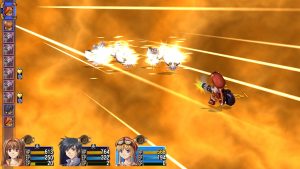 Aside from this, a rudimentary fishing system which is barely touched upon (and yet expanded further in the later games), and an extremely simple cooking system, the game is a little bare-bones as far as extras go — it’s heavily focused on telling a story and ushering the player through said story, and while the storytelling itself is excellent, it feels a little hand-holdy, offering little freedom beyond limited-time side-quests (the vast majority of which are issued from the regional Bracer Guilds) to explore beyond the scope of where the story wants to go. This shouldn’t be seen as too much of a negative point, however, as it means the important focus of the game — the story and character development — are almost constantly front-and-center.
Aside from this, a rudimentary fishing system which is barely touched upon (and yet expanded further in the later games), and an extremely simple cooking system, the game is a little bare-bones as far as extras go — it’s heavily focused on telling a story and ushering the player through said story, and while the storytelling itself is excellent, it feels a little hand-holdy, offering little freedom beyond limited-time side-quests (the vast majority of which are issued from the regional Bracer Guilds) to explore beyond the scope of where the story wants to go. This shouldn’t be seen as too much of a negative point, however, as it means the important focus of the game — the story and character development — are almost constantly front-and-center.
Without giving too much of the plot away, the story focuses largely on the journey of Estelle and Joshua — and friends they make along the way — throughout a sort of post-magic-industrial-revolution kingdom, doing odd jobs and good deeds along the way while uncovering an ever-deepening political conspiracy, along with trying to get to the bottom of their father’s mysterious disappearance. The story is competent, propped up largely by the extremely good writing and well-rounded characters, and does a good job setting the stage for the future games in the trilogy, while still being able to stand fairly firmly on its own two feet.
Overall, Trails in the Sky is a solid and enjoyable game which should appeal to both veteran and new players alike, though aside from its rather unique battle system, it feels as though the game tries far too much to paint inside the lines, and can feel a little bland in parts as a result. Just about every aspect of the game can fairly be described as being very good, though no particular area really stands out enough to truly excel.
